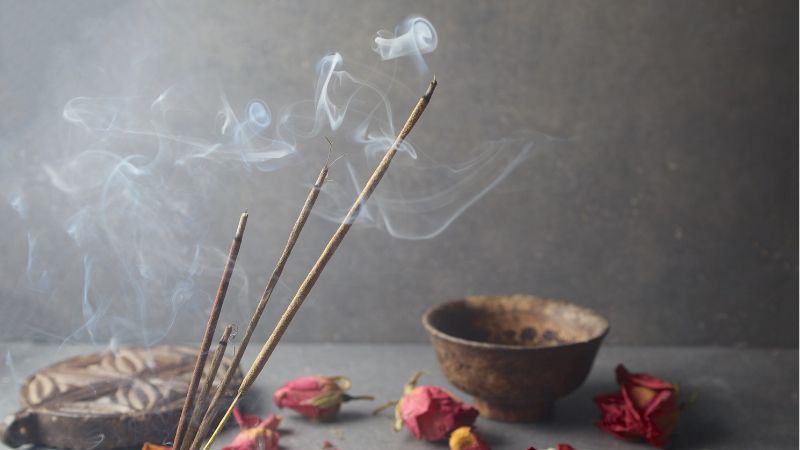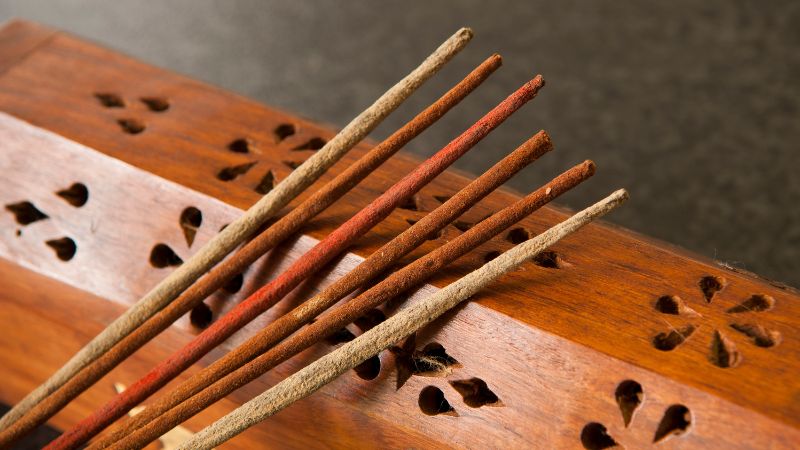
Caring for Your Incense Fountain: Tips and Tricks
An incense fountain can be a beautiful addition to any home or office. The soothing sound of trickling water combined with the aromatic scent of

Incense sticks, often associated with rituals and spiritual practices, are also popularly used around the world for creating an inviting, calm atmosphere at home or in the workplace.
But before you light an incense stick and let its fragrance waft through your space, it’s important to understand how to use incense sticks safely.
The art of burning incense sticks not only involves understanding the best way to light them but also requires knowledge of how to put out incense without causing any mishaps.
Therefore understanding how to handle lighting and extinguishing processes proves essential in our comprehensive guide on burning incense sticks.
First of all, let’s know the type of incense sticks.
Incense sticks span a wide spectrum of different types, each with its unique fragrances and uses. The most common types that you’ll come across in your incense journey are typically the Indian Masala and Tibetan incense sticks.
Indian Masala incense is created by blending solid scented ingredients into a paste and then rolling it onto a bamboo core stick. These are known for their rich and earthy scents.
On the other hand, Tibetan incense sticks usually don’t use a core bamboo stick but instead, are made from a blend of herbs, woods, and resins to create distinct aromas that can fill any room.
In recent years though, there’s also been an explosion of popularity around backflow incense cones.
These fascinating variations release smoke that flows downward rather than rising like traditional sticks or cones due to a small hole drilled through the center.
When lit correctly following an incense guide, they create stunning visual effects that add another layer to your sensory experience.
However, let’s not forget about the traditional Japanese “Senko” sticks either. They’re quite similar to Tibetan ones in that they lack a central bamboo core – but where they differ is in their composition.

Perfectly blended from aromatic woods, oils, herbs, and spices – these sticks emit less smoke when burning an incense stick while also providing more subtle fragrances.
And if you prefer something less smoky but still want all the benefits of burning incense sticks then you might lean towards aroma oil diffusers or electric burners which have become quite popular as well over time for their convenience and safety features.
Choosing a good holder or burner matters as much as picking out your favorite scent.
Your holder should be sturdy enough so your lit stick doesn’t topple over and robust enough not to catch fire itself (yes, this happens!). Aesthetics are also important!
For some people, burning incense sticks is part of ritualized beauty – they love watching tendrils of fragrant smoke curling into intricate patterns against a backdrop of beautiful objects such as backflow burners that look like miniature waterfalls when lit!
But before we get ahead ourselves here’s an essential pro-tip: always check the size of your chosen burner beforehand- specifically its hole diameter- lest you find out too late it’s not compatible with the incense stick length you’ve got in your hands.

Ah, the art of lighting incense. It’s not as simple as striking a match and setting the stick ablaze, no sir! It’s a delicate process that requires a bit of technique and mindfulness.
Now, the first thing you want to note is the incense stick length. If you’ve got an unusually long one, you might want to trim it down to a length that suits your burner or holder.
Alright then! Let’s dive right into how to light an incense stick.
You’ve got yourself a beautifully burning incense stick! You’ll notice soft smoke spiraling from your incense light; this is where all those lovely fragrances are released.
The best time to burn incense varies greatly depending on individual preference; some enjoy greeting morning’s first light with aromatic wisps while others prefer ushering in twilight with their favorite scents.
The point is to use incense when it best aligns with your mood or needs.
Now that we have our lit incense in hand (or safely nestled in its holder), let’s talk about how to put out an incense stick once you’re done with it. Simply let it burn out on its own?
First, you can snuff out the incense stick by pressing it into an ash catcher or another non-flammable surface.
Never try to blow it out like a candle; this could cause sparks and unintended fires.
Instead, gently press the burning tip into an ash-catching tray until it stops glowing and smoking — similar technique as when you light an incense stick but in reverse.
Another method is using a metal spoon or similar object to carefully choke off the oxygen supply from the burning tip.
Remember not to use anything plastic or easily melted — we don’t want any mishaps! It’s like cradling a small creature in your hands; be gentle but firm enough that the flame dies away completely.
How about backflow incense cones?
You wonder… Well, putting them out is just as simple yet requires attention just like any other form of burning incense sticks.
A quick tap on a solid surface will usually do it; just be prepared for some extra smoke as compared to when you light incense sticks of regular length.
Always remember that no matter what type of incense you use or how long your chosen incense stick length is – never leave it unattended while lit.
While many consider evenings as the best time to burn incense due to its calming effect before bed, remember that safety should always come first regardless of timing.

Remember, no matter how relaxing or meditative the practice might be, it’s essential to prioritize safety above all else.
– while partaking in burning incense can certainly add a certain ambiance or act as an aid in meditation practices – don’t ever forget these important safety measures.
In preparing this guide on incense, we looked at many reliable sources.
For example, we found a study highlighting the need to choose the right length of incense stick based on how long you want the scent to last.
Think of it like this: you wouldn’t use a huge hammer to open a small nut. Similarly, there’s no need to light a very long incense stick for a short aroma experience.
We also discovered interesting information about backflow incense sticks. These special sticks create beautiful smoke patterns, adding a visual element to your scent experience.
We also explored an old text that explained the spiritual side of using incense.
This text not only taught us how to use incense sticks but also explored their deeper meaning, including their significance in various cultures.
Interestingly, the text mentioned the best times to burn incense, noting that some cultures believe certain times are more favorable than others.
Lastly, the internet was an endless source of information, helping us dive deep into the world of incense.
We trust this comprehensive “incense guide” has equipped you with everything necessary for safe practices concerning lighting and extinguishing processes.
As we end our share here today, remember – burning an aromatic piece is not merely about releasing fragrant smoke into your surroundings but also about cultivating mindfulness amid our chaotic lives while ensuring everyone’s safety during such indulgences.
The more you know about how to light and use incense, the better your experience will be. Just like any other activity, burning incense sticks also requires some understanding and practice.
But with time, you’ll find your rhythm and rituals that suit your needs best. Happy burning!
If you’ve read through our article and still have questions, we’ve compiled a list of frequently asked questions below to help you further:
You should light the tip of the incense stick, which is the thinner end without the wooden base.
Hold the flame to it until it ignites and then gently blow out the flame. This will leave the incense smoldering and releasing its fragrance.
Yes, you can relight incense if it goes out. Just relight the tip as you did the first time.
However, if the incense has been burning for a while and there’s not much left, it’s better to start with a new stick for a full aroma experience.
If your incense won’t stay lit, it could be due to a few reasons. The incense might be damp, or the air in the room could be too humid.
Ensure your incense is stored in a dry place. Also, make sure you’re lighting it properly – the tip should glow red and smolder.
Yes, incense sticks are designed to burn out on their own once lit. They will smolder and release fragrance until they reach the wooden base, at which point they will naturally extinguish.
The burning time of an incense stick varies depending on its length and composition.
Typically, a standard incense stick burns for about 30 to 45 minutes.
However, there are longer sticks available that can burn for over an hour.
It’s not recommended to leave incense burning unattended. Always place the incense in a proper holder on a heat-resistant surface, away from flammable materials, and ensure the room is well-ventilated.
If you need to leave the room or go to sleep, it’s safer to extinguish the incense stick.


An incense fountain can be a beautiful addition to any home or office. The soothing sound of trickling water combined with the aromatic scent of

Meditation is an invaluable practice for reducing stress and attaining inner peace. While meditation’s benefits are profound on their own, tools like backflow incense burners

Incense has been an integral part of spiritual practice in The Chan Sect Buddhism for centuries. The burning of incense represents the ephemeral nature of

Incense fountains have become increasingly popular home decor items in recent years. The soothing sound of trickling water combined with the aromatic scent of incense

Incense sticks, often associated with rituals and spiritual practices, are also popularly used around the world for creating an inviting, calm atmosphere at home or

An incense fountain can be a beautiful addition to any home or office. The soothing sound of trickling water combined with the aromatic scent of

Meditation is an invaluable practice for reducing stress and attaining inner peace. While meditation’s benefits are profound on their own, tools like backflow incense burners

Incense has been an integral part of spiritual practice in The Chan Sect Buddhism for centuries. The burning of incense represents the ephemeral nature of
Copyright © 2024 burnwaterfallincense. All Rights Reserved.